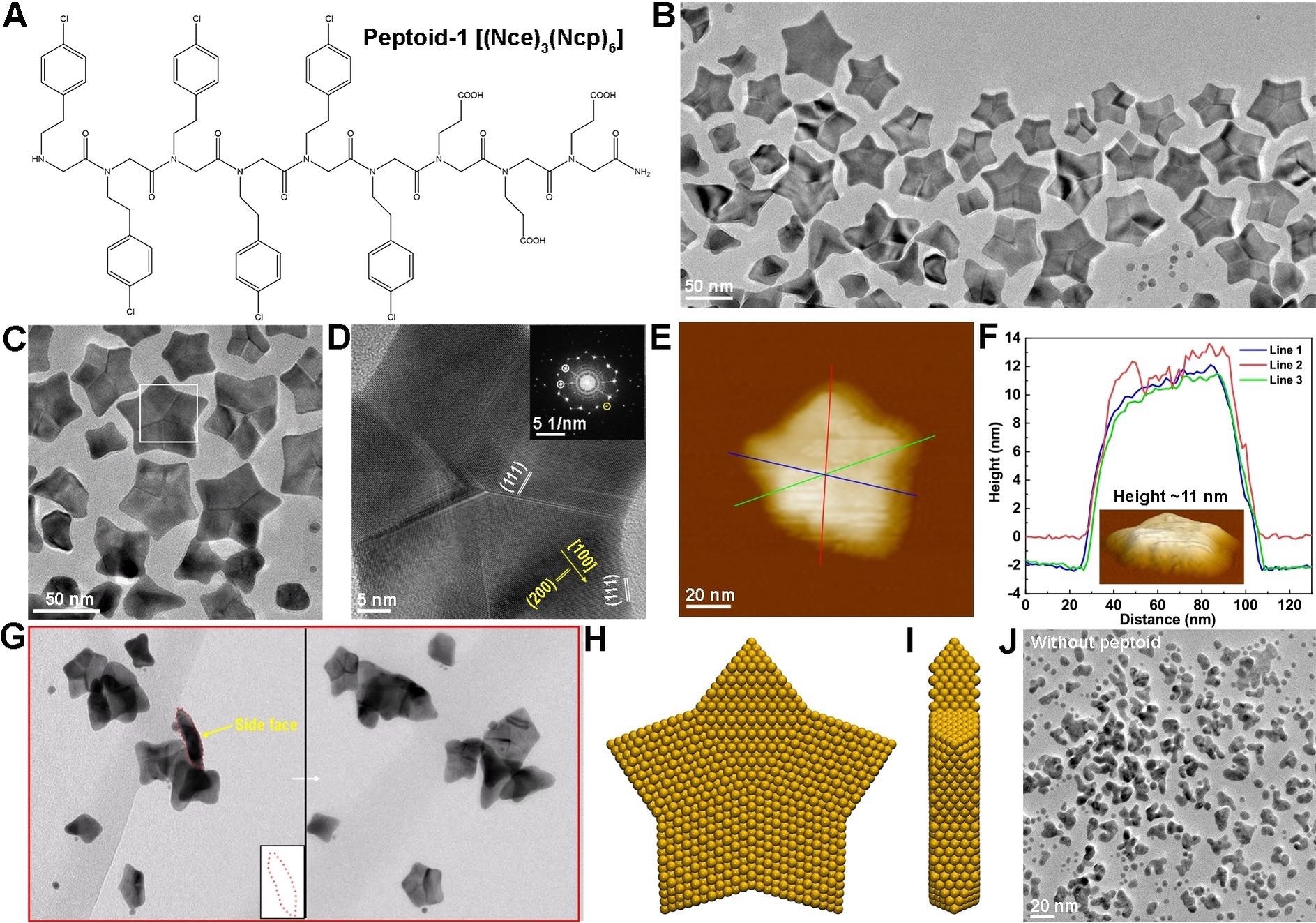Scientists from the Department of Energy's Pacific Northwest National Laboratory (PNNL) and the University of Washington (UW) have been successful in engineering a nature-inspired molecule that can guide gold atoms to form faultless nanoscale stars.
 Peptoid-Directed Formation of Five-Fold Twinned Au Nanostars through Particle Attachment and Facet Stabilization. Image Credit: Dr. Biao Jin, et.al (2022)
Peptoid-Directed Formation of Five-Fold Twinned Au Nanostars through Particle Attachment and Facet Stabilization. Image Credit: Dr. Biao Jin, et.al (2022)
The study is a significant step toward comprehending and regulating metal nanoparticle shape and developing innovative materials with tunable characteristics.
Metallic nanomaterials possess exciting optical features, known as plasmonic properties, states Chun-Long Chen, who is a PNNL senior research scientist, UW affiliate professor of chemical engineering and of chemistry, and UW–PNNL Faculty Fellow.
Specifically, star-shaped metallic nanomaterials are already said to display exclusive enhancements that are beneficial for sensing and the discovery of pathogenic bacteria, among other health and national security applications.
To form these remarkable nanoparticles, the researchers cautiously tuned sequences of peptoids, a type of adjustable protein-like artificial polymer.
Peptoids offer a unique advantage in achieving molecular-level controls.
Chun-Long Chen, Senior Research Scientist and Faculty Fellow, UW–PNNL
In this instance, the peptoids direct small gold particles to fasten and relax to develop larger five-fold twinned ones, while also stabilizing the facets of the crystal structure. Their method was nature-inspired, where proteins can regulate the formation of materials with innovative functionalities.
Jim De Yoreo and Biao Jin used cutting-edge in situ transmission electron microscopy (TEM) to “see” the stars’ creation in solution at the nanometer scale. The technique not only offered a comprehensive mechanistic understanding of how peptoids direct the process but also exposed the roles of facet stabilization and particle attachment in regulating shape.
De Yoreo is a Battelle Fellow at PNNL and affiliate professor of materials science and engineering at UW, and Jin is a postdoctoral research associate at PNNL.
After putting together their nanometer-scale constellation, the scientists then used molecular dynamics simulations to absorb a level of detail that cannot be derived from experiments — and to demonstrate why particular peptoids regulated the formation of the faultless stars.
Xin Qi, a chemical engineering postdoctoral researcher in Professor Jim Pfaendtner’s group, directed this study at UW. Qi used UW’s Hyak supercomputer cluster to model interfacial occurrences between many different particle surfaces and peptoids.
The simulations have a significant role to play in learning how to engineer plasmonic nanomaterials that capture and disperse light in distinctive ways.
You need to have a molecular-level understanding to form this nice star-shaped particle with interesting plasmonic properties.
Chun-Long Chen, Senior Research Scientist and Faculty Fellow, UW–PNNL
Simulations can construct the theoretical understanding of why specific peptoids form specific shapes.
The scientists hope to help establish a future where simulations direct experimental design, in a cycle the team hopes will result in predictive production of nanomaterials with preferred plasmonic enhancements. In this manner, they are keen to use computational instruments to detect peptoid side chains and sequences with preferred facet selectivity.
Then, they would use advanced in situ imaging methods, like liquid-cell TEM, to track the direct facet expression, stabilization and particle attachment.
If someone can tell us that a structure of plasmonic nanomaterials has interesting optical properties, can we use a peptoid-based approach to predictably make that?
Chun-Long Chen, Senior Research Scientist and Faculty Fellow, UW–PNNL
Although they are not yet at that point, this fruitful experimental-computational research is helping to bring them closer to this reality. Furthermore, the team’s capability to create perfect star shapes reliably is a vital step; more-homogeneous particles could mean more-predictable optical properties.
This study, published recently in the journal Angewandte Chemie, began with a 2019 grant from the U.S. Army Combat Capability Development Command’s Army Research Laboratory to create design guidelines for peptoids that create modifiable nanomaterials.
It came about because of growing partnerships between UW and PNNL in the materials synthesis space, including the cooperative initiatives Northwest Institute for Materials Physics, Chemistry, and Technology (NW IMPACT) and Materials Synthesis and Simulations Across Scales (MS3); and research funded by DOE through the Center for the Science of Synthesis Across Scales (CSSAS). These partnerships strongly benefit from the institutions’ twofold appointment program.
Journal Reference:
Jin, B., et al. (2022) Peptoid-Directed Formation of Five-Fold Twinned Au Nanostars through Particle Attachment and Facet Stabilization. Angewandte Chemie. doi.org/10.1002/anie.202201980.